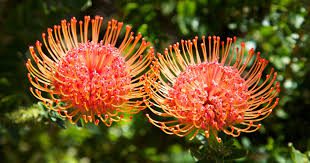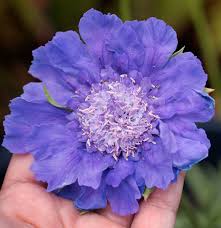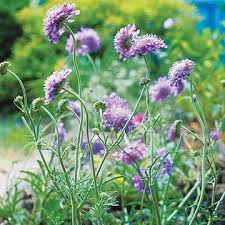Pincushion flowers, scientifically known as Scabiosa spp., are enchanting and charming additions to any garden. With their whimsical appearance and delicate blooms, these lovely plants have captivated the hearts of gardeners and flower enthusiasts alike. Native to Europe and Asia, pincushion flowers have become popular all around the world for their vibrant colors, long-lasting blossoms, and ease of cultivation.
Pincushion flowers derive their name from their unique resemblance to a pincushion, often adorned with a multitude of pins. Their distinct flower heads are made up of a central, cushion-like disk surrounded by tiny, slender petals that give them a pin-like appearance. These blossoms can come in various shades, including soft pastels, vibrant purples, pinks, blues, and even white, making them a versatile choice for any garden palette.
There are several delightful varieties of pincushion flowers available, each possessing its own special charm. Some popular ones include the Scabiosa caucasica, a perennial species with lavender-blue flowers, and Scabiosa atropurpurea, an annual type boasting rich, dark purple blossoms. Other common varieties like ‘Butterfly Blue’ and ‘Fama Deep Blue’ offer captivating sky-blue hues, while ‘Pink Mist’ presents a delicate pastel pink color that adds a touch of elegance to any garden bed.
One of the most appealing aspects of pincushion flowers is their easygoing nature when it comes to cultivation. They thrive in well-draining soil and prefer sunny spots, although they can tolerate partial shade. These hardy plants are relatively drought-resistant once established, making them a great choice for gardeners in various climates. Regular watering and occasional fertilization will encourage healthy growth and prolonged flowering.
Pincushion flowers are versatile in the garden and serve multiple purposes. They make stunning borders, adding pops of color along pathways or garden edges. Their attractive, nectar-rich blossoms also make them a favorite among pollinators, such as butterflies and bees, promoting a thriving ecosystem in your garden. Additionally, they are delightful cut flowers, creating beautiful floral arrangements that brighten up any indoor space.
Pincushion flowers generally bloom from late spring through the summer months, attracting attention with their abundant and long-lasting blossoms. With their extended blooming season, they provide continuous beauty and ensure your garden remains vibrant throughout the warm months.
For gardeners seeking low-maintenance yet striking blooms, pincushion flowers are an excellent choice. They require minimal fuss and can be left to flourish with minimal intervention. Regular deadheading – removing spent flowers – can encourage more blooms and keep the plant looking tidy.
In addition, pincushion flowers (Scabiosa spp.) are a delightful addition to any garden. With their enchanting appearance, diverse colors, and ease of care, they effortlessly capture the hearts of gardening enthusiasts worldwide. Whether you’re an experienced gardener or a novice, these lovely flowers will bring joy and beauty to your outdoor space, attracting beneficial pollinators and providing a lasting display of natural elegance. So, consider adding pincushion flowers to your garden and witness the magical allure they bring to your landscape.
History and Significance of Pincushion Flowers

The history of pincushion flowers dates back centuries, and their significance has evolved through cultural, medicinal, and horticultural uses.
Pincushion flowers, belonging to the Scabiosa genus, have a rich history originating from Europe and Asia. The name “Scabiosa” is derived from the Latin word “scabere,” which means “to scratch,” alluding to their traditional use in herbal medicine to treat various skin ailments. In ancient times, people believed that the rough leaves of these plants could alleviate itching or scratchiness, hence the name.
Throughout history, pincushion flowers have held symbolic meanings in different cultures. In the Victorian era, the language of flowers was popular, and each flower carried a specific message. Pincushion flowers were associated with purity, gratitude, and healing. They were often given as gifts to convey appreciation and well-wishes, making them a favorite choice for bouquets and posies during that era.
Before modern medicine, pincushion flowers were utilized for their supposed healing properties. In traditional herbal medicine, the roots, leaves, and flowers of the plant were used to create poultices and ointments to treat skin conditions like eczema, rashes, and wounds. Although not extensively employed in modern medicine, certain compounds found in pincushion flowers have been studied for their potential medicinal properties, and ongoing research continues to explore their pharmacological applications.
Over the years, pincushion flowers have become increasingly popular in horticulture due to their ornamental value and ease of cultivation. Horticultural enthusiasts and gardeners recognized the beauty and charm of these flowers, leading to their introduction in gardens and landscapes worldwide. As their popularity grew, breeders developed various cultivars with an array of colors and improved traits, enhancing their appeal even further.
Apart from their historical and cultural significance, pincushion flowers also hold ecological importance. As attractive nectar sources, they play a crucial role in supporting pollinators like butterflies, bees, and other beneficial insects. By attracting these pollinators, pincushion flowers aid in promoting biodiversity and ensuring the reproduction of other flowering plants.
With habitat loss and environmental changes impacting many plant species, some native pincushion flower species may face threats in their natural environments. Consequently, conservation efforts and initiatives have emerged to protect and preserve these plant species, ensuring their survival and continued contribution to the ecosystem.
In addition, the history and significance of pincushion flowers (Scabiosa spp.) are woven into the fabric of human culture, medicine, and horticulture. From their ancient use in herbal remedies to their role as a symbol of gratitude and purity in Victorian times, these delightful blooms have left a mark on the collective consciousness. Today, as cherished garden additions, they continue to captivate with their beauty while fostering ecological balance by attracting important pollinators. By appreciating and conserving these fascinating flowers, we honor their historical and ecological significance, ensuring that future generations can also enjoy the splendor of pincushion flowers in gardens and nature alike.
Uses of Pincushion Flowers

Pincushion flowers (Scabiosa spp.) have a variety of uses, ranging from ornamental and aesthetic purposes to potential medicinal applications. Let’s look at some of the main uses of these delightful blooms:
1. Ornamental Purposes:
Pincushion flowers are primarily cultivated for their ornamental value. With their charming and whimsical appearance, they add a touch of elegance and beauty to gardens, landscapes, and floral arrangements. Gardeners often use them as border plants, in mixed flower beds, or as focal points in a garden design. Their vibrant colors and long-lasting blossoms make them a favorite choice for creating eye-catching displays in both residential and public spaces.
2. Cut Flowers and Floral Arrangements:
One of the most popular uses of pincushion flowers is as cut flowers for floral arrangements. Their unique pin-like appearance and delightful colors make them stand out in bouquets, centerpieces, and posies. They blend well with other flowers, foliage, and various floral elements, making them a versatile addition to any floral composition.
3. Pollinator Support:
Pincushion flowers play a vital role in supporting pollinators such as butterflies, bees, and other beneficial insects. Their nectar-rich blooms attract these pollinators, providing them with a valuable food source. By encouraging pollinators to visit your garden, pincushion flowers contribute to the pollination of other nearby plants, ensuring their reproduction and fostering biodiversity.
4. Herbal and Medicinal Uses:
Historically, pincushion flowers were used in traditional herbal medicine for their supposed medicinal properties. The plant was thought to have soothing and healing effects, particularly for skin conditions like eczema and rashes. However, it is essential to note that modern medical practices and evidence-based medicine do not widely endorse these traditional uses. Always consult a qualified healthcare professional before using any plant for medicinal purposes.
5. Aesthetics and Crafts:
Beyond their traditional uses, dried pincushion flowers can be used in various craft projects. Their intricate shapes and captivating appearance make them ideal for creating decorative items like potpourri, wreaths, and pressed flower art.
6. Educational Purposes:
Pincushion flowers also serve educational purposes, particularly in botanical studies and horticulture. As gardeners cultivate and observe these plants, they learn about various aspects of plant growth, care, and botanical characteristics. Additionally, they provide an excellent opportunity for teachers and educators to introduce students to the fascinating world of plant life and ecology.
7. Conservation and Biodiversity:
In regions where native pincushion flower species are endangered or at risk, their cultivation in gardens and protected areas can contribute to conservation efforts. By growing these plants, gardeners help preserve genetic diversity and ensure the survival of threatened plant species.
However, pincushion flowers (Scabiosa spp.) serve a multitude of uses, from their primary role as ornamental garden plants and cut flowers to their significance in supporting pollinators and potentially contributing to traditional herbal medicine. Whether brightening up landscapes, providing nectar for butterflies and bees, or adding a touch of beauty to floral arrangements and crafts, pincushion flowers continue to be cherished and valued for their myriad of uses.
Complete Growing Guide of Pincushion flowers

Pincushion flowers are delightful additions to any garden, offering vibrant colors, unique appearances, and long-lasting blooms. Whether you’re an experienced gardener or just starting, here’s a comprehensive growing guide to help you cultivate and care for these beautiful plants:
1. Selecting the Right Location:
Pincushion flowers thrive in full sun to partial shade, so choose a spot in your garden that receives at least 6-8 hours of sunlight per day. Ensure that the location has well-draining soil to prevent waterlogged conditions, as these plants prefer slightly dry to moderate moisture levels.
2. Soil Preparation:
Prepare the soil before planting by incorporating organic matter such as compost or well-rotted manure. This enriches the soil, improves drainage, and provides essential nutrients for healthy growth. Pincushion flowers prefer a slightly alkaline to neutral soil pH ranging from 6.0 to 7.5.
3. Planting Time:
In temperate climates, pincushion flowers can be planted in spring after the last frost has passed. In warmer regions, they can also be planted in the fall. Alternatively, you can start them indoors several weeks before the last expected frost and transplant them outside once the weather is suitable.
4. Planting Technique:
Dig a hole that is slightly larger than the root ball of the pincushion flower plant. Gently remove the plant from its nursery pot and place it in the hole at the same depth it was previously growing. Backfill the hole with soil, pat it down gently, and water thoroughly.
5. Watering:
While pincushion flowers are relatively drought-tolerant once established, they require consistent watering during their initial growth period. Water the plants at the base, aiming to keep the soil slightly moist, but avoid overwatering, as they don’t tolerate waterlogged conditions well.
6. Fertilization:
To encourage healthy growth and prolonged flowering, you can apply a balanced fertilizer during the growing season. Use a slow-release fertilizer or a liquid fertilizer diluted to half strength every 4-6 weeks. Be careful not to over-fertilize, as excessive nutrients can lead to leggy growth and reduced flowering.
7. Mulching:
Applying a layer of organic mulch around the base of the pincushion flowers helps retain moisture, suppresses weed growth, and regulates soil temperature. Mulching also enhances soil health as it decomposes over time.
8. Deadheading:
To encourage continuous blooming, remove spent flowers regularly by deadheading. Pinch off the faded blooms just above a healthy set of leaves or buds. This practice not only prolongs the blooming period but also keeps the plant looking tidy.
9. Support and Pruning:
Taller varieties of pincushion flowers may benefit from staking or support as their stems can become top-heavy with blooms. Use bamboo stakes or other supports to prevent flopping. Pruning the plant lightly after the first flush of flowers can encourage a second round of blooms later in the season.
10. Winter Care:
In colder climates, pincushion flowers may be treated as perennials or annuals, depending on the specific species and local climate. Some varieties are hardy enough to withstand frost, while others may need protection or be treated as annuals and replanted each year.
11. Propagation:
Pincushion flowers can be propagated through division or from seeds. To propagate by division, carefully separate clumps of mature plants in early spring. For seed propagation, collect ripe seeds from the plant after flowering and sow them directly in the garden or indoors.
By following this growing guide, you can enjoy the beauty of pincushion flowers in your garden and create an inviting space for pollinators while adding a touch of charm and color to your outdoor landscape. With their low-maintenance nature and wide array of varieties, pincushion flowers are sure to bring joy and delight to your gardening endeavors.
Read Also: Best Harry Potter Lego Toy Sets For Kids
